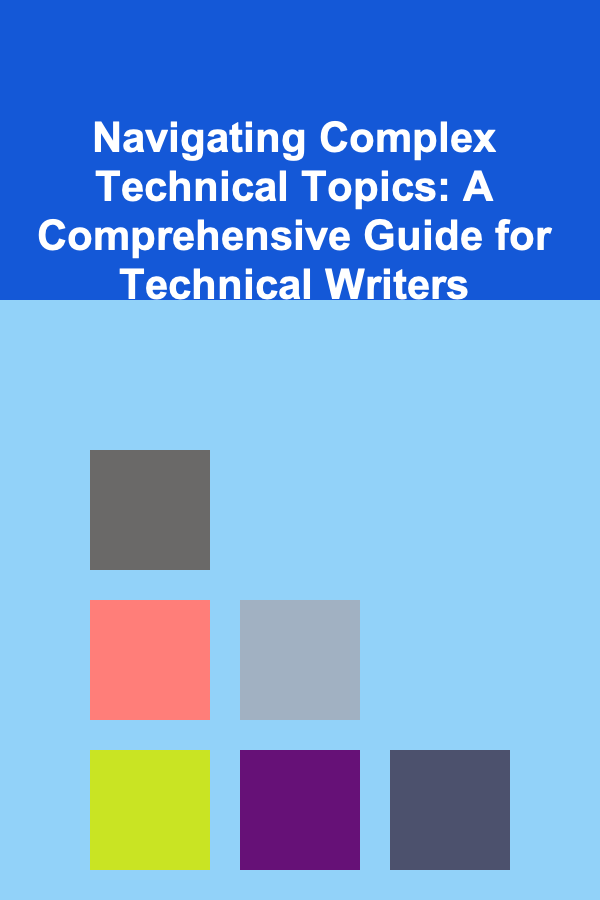
Navigating Complex Technical Topics: A Comprehensive Guide for Technical Writers
ebook include PDF & Audio bundle (Micro Guide)
$12.99$5.99
Limited Time Offer! Order within the next:

Technical writing can be an intimidating field, especially when tasked with explaining complex topics to diverse audiences. Whether you're writing manuals, software documentation, API guides, or troubleshooting documentation, your goal is to simplify complex concepts without oversimplifying the content. In this comprehensive guide, we'll explore actionable strategies that will help you navigate and communicate intricate technical topics with clarity and precision.
Understanding Your Audience
The cornerstone of effective technical writing is understanding your audience. Whether you're writing for experienced developers, end-users with limited technical knowledge, or non-technical stakeholders, your writing style, tone, and level of detail must adapt to their expertise and needs.
Actionable Steps:
- Identify the Audience's Expertise Level: If your readers are experts in the field, you can assume they have a high level of technical knowledge. For beginner audiences, however, you'll need to break down concepts into simpler language and provide more context.
- Define the Reader's Goal: Understand what the audience needs to accomplish by reading your content. Are they troubleshooting an issue, learning to use new software, or trying to understand a technical specification? Tailor your content to meet their needs.
- Consider the Context: Technical documents often have a specific context---like the environment or tool in which the user will apply the knowledge. Include relevant information like system requirements, installation procedures, or limitations specific to the context.
Key Takeaway:
Understanding your audience ensures that your writing resonates with them. By tailoring content based on their technical background, knowledge gaps, and objectives, you can create more effective and engaging documentation.
Simplifying Complex Concepts
Breaking down technical jargon and complex concepts into easily digestible parts is one of the most important skills of a technical writer. When dealing with intricate topics, your challenge is to simplify without losing critical details.
Actionable Steps:
- Chunk Information: Divide the information into smaller, manageable sections (or "chunks"). This allows readers to focus on one concept at a time and understand the material more easily.
- Use Analogies: Analogies can make abstract technical concepts more relatable. For example, explaining data flow in programming with the analogy of a water pipe system can help clarify how data moves through different stages.
- Create Visual Aids: Diagrams, flowcharts, and screenshots are invaluable for illustrating complex ideas. A well-designed visual can often explain a concept more effectively than a thousand words.
- Define Key Terms: When introducing complex terminology, make sure to define it early on. Glossaries, tooltips, or sidebars are helpful to ensure that readers don't get lost in technical terms.
- Use Step-by-Step Instructions: Breaking down a process into clear, sequential steps can make even the most complex procedures easier to follow. Consider using numbered lists and highlighting important actions.
Key Takeaway:
By simplifying complex concepts into smaller chunks, using analogies, and integrating visuals, you can make dense technical information more approachable without sacrificing accuracy.
Maintaining Accuracy and Clarity
While simplification is essential, it's just as important to maintain technical accuracy. In technical writing, you walk a fine line between making things accessible and keeping the integrity of the information intact.
Actionable Steps:
- Collaborate with Subject Matter Experts (SMEs): Collaborating with SMEs is crucial for ensuring the accuracy of technical content. They can clarify complex aspects of a topic, review drafts, and validate details.
- Use Precise Language: Avoid ambiguity by being as precise as possible. For instance, instead of saying "a lot of data," specify the exact quantity or range. Vague language can confuse your audience and lead to misinterpretation.
- Stay Updated: Technology evolves rapidly, so you must stay on top of updates in the field. Regularly review and update your documentation to reflect new developments, features, or changes in industry standards.
- Document Assumptions and Limitations: Clearly state any assumptions or limitations regarding the technology or process you're describing. If something works only in a specific scenario or environment, make sure to specify that upfront.
Key Takeaway:
Accuracy is paramount in technical writing. By working closely with experts, using precise language, and staying current with industry trends, you ensure that your content is both reliable and easy to understand.
Organizing Information Effectively
Well-organized content is easier to read and follow. Effective structure not only improves readability but also helps the reader find specific information quickly.
Actionable Steps:
- Create a Logical Flow: Information should follow a logical order. For example, when writing a user guide, start with the basics (installation), move on to core functionalities, and then dive into advanced features.
- Use Headings and Subheadings: Organize your content into sections with clear and concise headings. This structure allows readers to skim and quickly find relevant information.
- Include an Index or Search Functionality: For longer documents, providing an index or search feature can help users navigate the content efficiently.
- Leverage Lists and Bullet Points: Bullet points are an excellent way to present key points concisely. Lists help break down information, making it easier to digest.
Key Takeaway:
Effective organization helps guide readers through complex information. Using a clear structure with headings, bullet points, and logical sequencing allows users to understand content more easily and locate specific details when needed.
Engaging the Reader through Tone and Style
The tone and style of your writing can influence how well your audience engages with the material. Technical writing doesn't have to be dry or impersonal; it can be clear, friendly, and engaging, which encourages the reader to stay focused and absorb the material.
Actionable Steps:
- Be Direct and Concise: Readers of technical documentation appreciate brevity. Avoid unnecessary jargon and filler words. Focus on delivering just the right amount of information.
- Use Active Voice: Active voice makes sentences clearer and more direct. For example, "The system processes the data" is clearer than "The data is processed by the system."
- Balance Formality and Approachability: While technical writing often requires a formal tone, make sure it's not overly stiff. You can keep it professional while using a conversational tone that feels approachable.
- Avoid Overuse of Acronyms: While acronyms and abbreviations are common in technical writing, overusing them can confuse readers. Define each acronym the first time you use it and, when possible, use the full term thereafter.
Key Takeaway:
Striking the right balance between formal and approachable tones, and keeping your writing direct and concise, helps maintain reader engagement while ensuring clarity and precision.
Leveraging Tools and Resources
Modern technical writers have a wide variety of tools at their disposal. From content management systems to collaborative platforms, leveraging the right tools can streamline the writing process and ensure the production of high-quality documentation.
Actionable Steps:
- Use Documentation Platforms: Tools like Confluence, MadCap Flare, or DITA XML help you structure and organize your documents efficiently. These platforms also facilitate collaboration with other team members and SMEs.
- Integrate Version Control: When writing documentation for constantly evolving products, version control tools (like Git or SVN) are invaluable. They allow you to keep track of changes and collaborate more effectively with developers.
- Incorporate Feedback Loops: Use collaborative platforms like Google Docs or Microsoft Word's comment feature to solicit feedback from SMEs or stakeholders. Engaging with others early and often ensures accuracy and clarity.
- Maintain a Style Guide: A technical writing style guide ensures consistency in your writing. It provides guidelines on tone, terminology, formatting, and best practices to follow.
Key Takeaway:
Using the right tools helps optimize the technical writing process and ensures consistency, collaboration, and quality in your work.
Testing and Refining Documentation
The work doesn't end once the document is written. Testing and refining your content ensures that it effectively serves the needs of its readers and functions as intended.
Actionable Steps:
- Test Instructions: Before finalizing a user guide or tutorial, run a test where someone who hasn't used the product follows the instructions. This will help identify areas that may need further clarification.
- Seek User Feedback: Ask real users to review your documentation. Their feedback will highlight potential ambiguities or areas where they struggle to understand the content.
- Iterate Based on Feedback: Regularly update documentation based on feedback, product updates, and user queries. Iteration is essential for maintaining useful and relevant technical content.
Key Takeaway:
Testing and continuously refining your documentation ensures that it meets the needs of the users. It allows you to catch errors, clarify confusing sections, and keep the content up-to-date.
Conclusion
Navigating complex technical topics as a writer requires a combination of deep understanding, clear communication, and an ability to make difficult concepts accessible. By focusing on your audience, simplifying complexity, ensuring accuracy, organizing your content effectively, and refining your documentation based on real-world feedback, you can master the art of technical writing. The more you practice these techniques, the better equipped you will be to tackle any technical subject and communicate it with clarity and precision.
In the world of technical writing, your ability to distill intricate topics into understandable, engaging, and accurate content will ultimately determine the effectiveness of your documentation. Keep learning, refining, and collaborating, and you'll succeed in making complex technical content a valuable resource for your audience.
Reading More From Our Other Websites
- [Skydiving Tip 101] Extreme Heights: Exploring Record-Breaking Skydiving Altitudes
- [Personal Care Tips 101] How to Apply Toner for Maximum Benefits
- [Personal Finance Management 101] How to Build a Financial Safety Net for Your Family
- [Home Family Activity 101] How to Create a DIY Pizza Night at Home
- [Home Soundproofing 101] How to Reduce Noise from Neighbors: Simple Solutions for Quieter Living
- [Home Security 101] How to Identify Weak Points in Your Home's Security
- [Gardening 101] The Best Plants for a Low-Maintenance Shade Garden
- [Simple Life Tip 101] How to Cultivate a Simple Mindset Through Daily Gratitude Practices
- [Biking 101] Cyclocross vs. Road Bikes: What's the Difference and Which Should You Choose?
- [Home Space Saving 101] How to Fit Your Home Gym Equipment into a Small Room

A Beginner's Guide to Utilizing Public Transportation Efficiently
Read More
How to Sell Digital Products Successfully for Bloggers
Read More
How to Set Up a Checklist for Mulching and Composting
Read More
Top Tips for DIY Home Repairs and Maintenance You Can Do Yourself
Read More
How To Master the Ancient Wisdom of the Stoics
Read More
Experiencing the Safari in South Africa: A Comprehensive Guide
Read MoreOther Products

A Beginner's Guide to Utilizing Public Transportation Efficiently
Read More
How to Sell Digital Products Successfully for Bloggers
Read More
How to Set Up a Checklist for Mulching and Composting
Read More
Top Tips for DIY Home Repairs and Maintenance You Can Do Yourself
Read More
How To Master the Ancient Wisdom of the Stoics
Read More